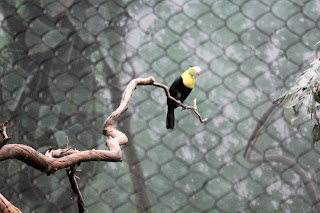Wednesday, February 29, 2012
Recipe of the Week: Chicken Pot Pie with Corn Bread Crust
I made up this recipe this week because both Matt and I have colds, and I wanted something hearty and warm to eat.
3 cups chicken thighs, cut into one inch cubes
2 cups pre-sliced mushrooms
1 medium onion diced
1 (16 oz) bag baby carrots
1 (14.5 oz) can cut green beans (low sodium)
1 (15 oz) can green peas (low sodium)
1 (10 3/4 oz) can cream of chicken soup
1 (10 3/4 oz) can cream of potato soup
1 bag Marie Calendar's® Original Cornbread Mix (Low Fat)
Preheat the oven to 375° F
Add the baby carrots to a pot with about two cups boiling water and boil the carrots until they are tender. Meanwhile, combine the chicken, mushrooms and onion in a frying pan and cook until the chicken is cooked all the way through. I like to wait until there is a little golden brown on the bottom of the concoction.
Drain the green beans and green peas and mix them together in a large bowl, then mix in the cream of potato soup and cream of chicken soup (don't add any water to the soup!). Drain the water from the boiling carrots and add them to the green bean bowl. Finally add the chicken, mushrooms and onions to the green bean bowl and thoroughly mix all the vegetables, chicken and soup together, and then put the mixture in the bottom of a large casserole dish. Make the cornbread by following the directions on the box, and then pour the batter over the top of the vegetables and chicken.
Bake for 35 minutes and then reduce the heat to 350° F, and continue to bake for about 10 minutes or until a knife inserted into the center of the bread comes out clean. Cool for a couple minutes before eating and enjoy!
Wednesday, February 22, 2012
Most Recent Read: The Immortal Life of Henrietta Lacks
I liked that Skoot took a holistic approach to telling the story. I am really glad she didn't paint out all the scientists and doctors as heartless people. I was impressed to learn that the Doctor who took the cancer cells from Henrietta Lacks, was willing to have experimentation done on his cells. Dr. George Gey [pronounced guy] first grew the HeLa cell line. When he found out he had pancreatic cancer, he insisted the surgeons take samples of his tumor while Gey was being operating on. Gey was willing to use himself as a test subject (171).
So, random interpolation, I have thought for years now that science could be art. One time I walked into the pathology lab I was researching in and some crystal violet was left in the sink. It was a like an oil spill of gold and dark purple. I really wanted to take a picture. When I would look thorough the microscope at gram stained cultures, I was amazed at how remarkable they were. Skoot writes, "Christoph had famed a foutreen-by-twenty-inch print of Henrietta's chromosomes that he'd "painted" using FISH [fluorescence in situ hybridization]. It looked like a photograph of a night sky filled with multicolored fireflies glowing red, blue, yellow, green, purple, and turquoise" (234). I am really happy that I am not the only one who thinks photographs from science can be art.
When John Moore's spleen was removed and then used for profitable research, Moore sued David Golde, the Doctor who took his spleen. But Moore lost the initial suit and eventually lost his suit against the Supreme Court of California, which ruled, "When tissues are removed from your body, with or without your consent, any claim you might have had to owning them vanishes" (205). A similar situation happened to Ted Slavin, but there is a critical difference between the two cases; the doctor treating Slavin told him how valuable his cells were before they were removed. Therefore, Slavin was in control of what happened to his lucrative tissues (202).
It is a tricky issue to deal with. It seems logical that a person's cells should still be considered their property even after those cells are removed, however, the judge ruling on the case feared litigation disputes over cell ownership would impede valuable research. However, because of the ruling, scientists were able to claim ownership of the cells, which ended up impeding research.
Myriad Genetics, a company in Utah, was referenced as one of the companies that holds patents for genes (BRCA1 ad BRCA2). In the Afterward, Skoot writes "In May 2009 the American Civil Liberties Union, several breast-cancer survivors, and professional groups representing more than 150,000 scientists sued Myriad Genetics over its breast-cancer gene patents. Among other things, scientists involved in the case claim that the practice of gene patenting has inhibited their research, and they aim to stop it. The presence of so many scientists in the suit, many of them from top institutions, challenges the standard argument that ruling against biological patents would interfere with scientific progress...Many scientists have interfered with science in precisely the way courts always worried tissue donors might do" (324).
It is a tricky issue. While the original cells studied may have come from Lacks, Moore and Slavin, they did not have the tools or skills necessary to personally do anything with their cells. It was necessary for researchers to analyze and synthesize those cells before they were useful. Furthermore, because of the research done in the past century with individual cell lines, HeLa cells especially, thousands, if not millions of lives have been saved. Although, if doctors are taking samples away from the patients without informing them, or compensating them, the least the doctors can do is make those samples available so everyone can benefit from the cures developed from those cells.
It is Official
Walking backing from the Seattle library today, someone asked me for directions! I think that means I'm officially a Seattlite! Well that, and I have a library card.
Monday, February 20, 2012
Zoo-a-pa-looz-a!
Australasia
Snow Leopard!
Rawr! Except Snow Leopards cannot rawr
Then he left.
Tiger, which was content to hide in his corner
Malayan Sun Bear
Tropical Rain Forest
Snnikity-snake!
Snnikity-snake again!
Green Snnikity-snake
Turtle!
Turtle looking at me!
Lizard!
Creepy Toad. He will Kill you.
Jaguar
Ocelot hiding in a tree
Poison Tree Frogs
Golden Tamarin
Little Toucans
A little bigger Toucan
African Savanna
Lemur
GOR-ILL-A
Little Gorilla
Peacock
Ostrich, with ostrich eggs in the background!
Giraffe
Patas Monkey
Lions. Sleeping.
Tropical Asia
Elephant
Macaque Monkey
Siamang
Hanging around. Y'now.
Orangutan; we thought he wouldn't turn around...
But he did!
Northern Trail
Wolf! Boys becoming men, Men becoming wolves!
Snowy Owl or Hedwig
Bears. Possibly Brother Bears.
Mountain Goat
Sea Eagle
Ominous Crow
Penguin!
Matt and I had so much fun at the Woodland Park Zoo! We saw so many of my favorite animals, a snow leopard, tigers, and giraffes. Yay!
Subscribe to:
Posts (Atom)























































